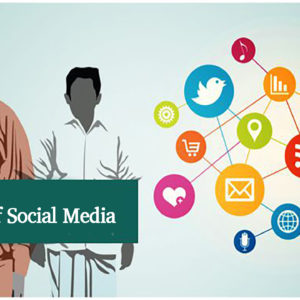
The paradigm of the use of technology and social media in election campaigns has drastically shifted since the 2014 Lok Sabha elections. This included the shift of campaigning structures from Newspaper advertisements, Flyers and New Channels to proper strategies dedicated to harnessing technology, data and online platforms. In 2014 elections social media affected 30 to 40 percent of overall seats and this numbers are expected to go up to 60 per cent by the 2019 general elections. In many constituencies, social media was amongst the top three communication tools, overtaking traditional methods such as advertisements. The rise of the internet has provided voters with a wealth of information which they can use to gain a deeper understanding of the candidates, their histories and beliefs and make an informed decision. Since their inception, social media platforms such as Facebook and Twitter have helped the politicians extensively to promote their ideas and ideologies.
Some of the prominent new methods of targeting the voters are:
- Profiling voters according to age and caste groups and targeting them with customized voice messages of political leaders.
- Use of apps (for example NaMo app launched by BJP government), social media and missed calls to collect voter’s personal data.
- Use of WhatsApp, Facebook etc. to target young and first-time voters.
- Spotting influencers with smartphones, to propagate their ideologies.
- Use of GPS in campaign vans to increase efficiency.
- Micro-managing of polling booth with a collection of real-time data.
The use of smartphones and the internet has gained steady momentum in India and also the expansion of 4G to rural villages has increased the number of connected users in India. With almost 500 million internet users, 226 million Facebook users and 33 million Twitter users data connectivity in India has reached in many rural areas as well. Consequently, digital technologies and tools have become a key communication tool for political parties. According to the data the number of Twitter users has doubled from the stats in 2014.
Around 42 percent of individuals falling in the age group 15-24 years are from rural backgrounds, which is more than the urban population where around 31 percent of users are from age group 15-24 years. While in the age group 25-34 years the rural population is 23 percent whereas the urban population users are 26 percent. This age bar helps the candidates influence young population and mostly first-time voters and woo them to their ideologies.
It’s very likely that the 2019 elections will rely more on Social Media than the 2014 elections, with video content playing even more prominent part. In the run-up to state and other by-elections held in and around 2018, Congress and BJP reportedly created over 50,000 WhatsApp groups to spread campaign messages. Narendra Modi seems to have solved the puzzle of how to reach the world’s largest electorate. During the 2014 elections, his technology-based campaign was one of the major factors that contributed to his glorious victory. He addressed rallies throughout the country simultaneously as a hologram. The BJP and Modi ran a breathless and tech-savvy campaign that dazzled and engaged voters directly through social media. Modi snapped campaign selfies that went viral.
In contrast to Flyers and Newspaper advertisements, Beacons have emerged as a cost-effective platform and also provide an unbelievable ROI. Beacons are essentially small transmitters that can broadcast messages in the form of campaigns to Bluetooth enables smartphones nearby. They work on the principle of proximity marketing and serve as a perfect tool for candidates to reach out to their supporters.
Although there is a growing trend towards digital and data-driven campaign in India, the current regulatory framework for how this data can be used is not adequate. In fact, the current electoral rules and media regulations do not yet fully address the use of sensitive personal data or information (SPDI) or personal information (PI), particularly in the context of elections. And therefore, there’s an increasing need to regulating the social media campaigns and framing proper legislation for the use of same.
Graph 1: Number of Smartphone Users in India in millions

*- denotes the estimated data
Graph 2- Number of Facebook Users in India in millions

*- denotes the estimated data
Graph 3- Number of Twitter Users in India in millions

*- denotes the estimated data